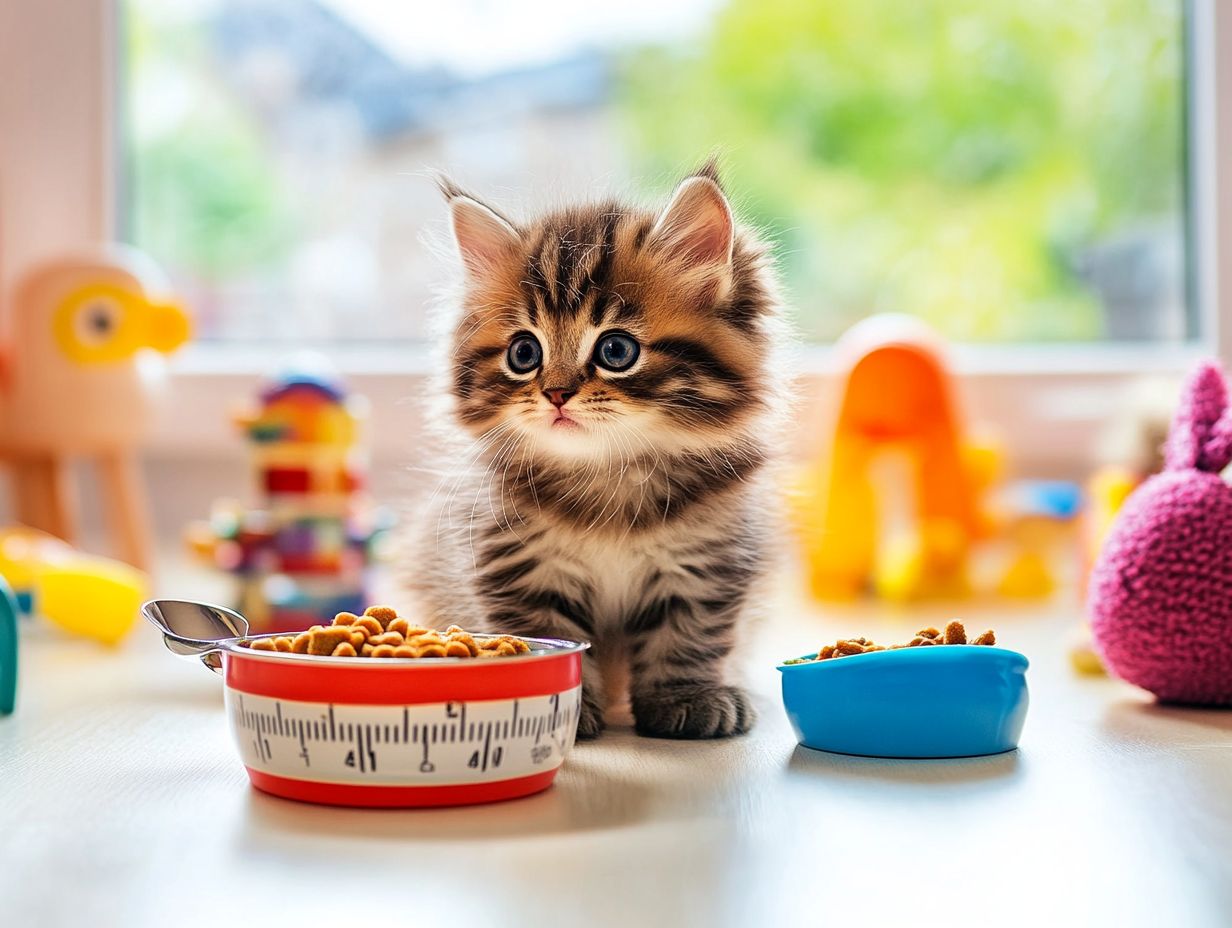Feeding your kitten the right way is essential for their growth phase and overall health benefits. As obligate carnivores, kittens require a diet rich in animal-source proteins to thrive. This guide covers everything from wet and dry food to homemade meals, ensuring your little furball gets the best start in life.
With so many feeding options available, you might wonder what kitten foods are best suited for their nutritional needs. While wet, dry, and homemade foods can be suitable, they should meet AAFCO standards for complete and balanced nutrition. This guide also discusses how much and how often to feed your kitten, with feeding guides and mealtime tips for managing their eating habits.
Read on to discover the best feeding practices for your new companion!
Key Takeaways:
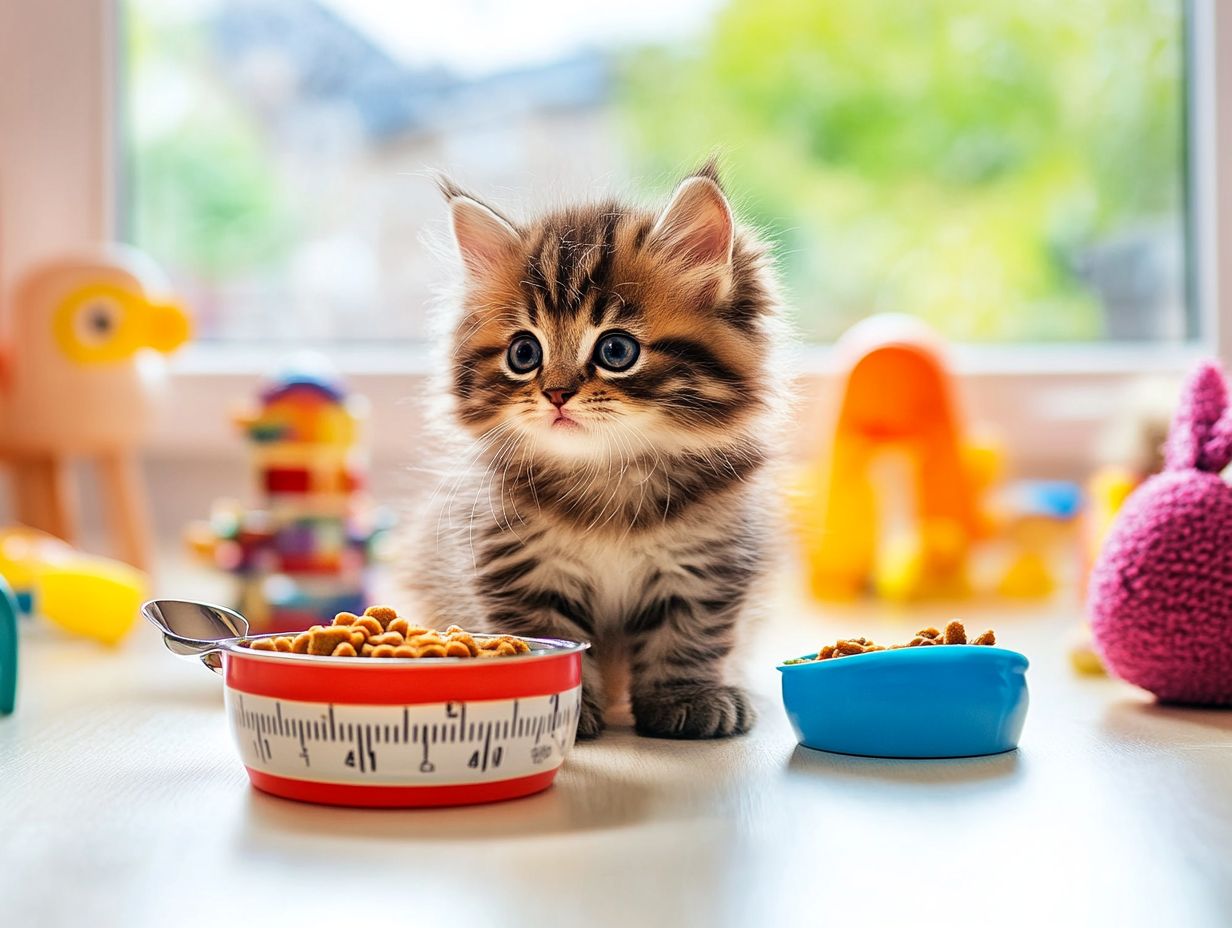
What to Feed Your Kitten?
Feeding your kitten is one of the most essential responsibilities to meet their nutritional needs during the growth phase. A well-balanced diet that includes a variety of high-quality options, such as wet kitten food, dry kitten food, and even homemade meals, ensures that your kitten receives the essential protein sources, vitamins, and minerals necessary for healthy development. It’s important to understand your kitten’s specific nutritional requirements to make informed decisions that promote their growth and vitality.
1. Wet Food
Wet food is an excellent choice for feeding kittens due to its high moisture content, which promotes hydration and supports digestive health in young animals. However, it should not replace free access to fresh, clean water, as hydration is vital regardless of diet type. The rich flavors and textures of wet kitten food can entice picky eaters, ensuring they receive the necessary nutrients.
Additionally, wet food can significantly enhance a young animal’s appetite, transforming mealtime from a chore into an enjoyable experience. The variety of flavors available in the wet food category—such as chicken, tuna, and beef—makes premium products easily accessible.
Veterinarians often recommend incorporating wet food into a kitten’s diet to maintain a healthy balance of water and nutrition, especially during the weaning process. Adhering to recommended feeding practices that include a mix of wet and dry food can further improve the overall health of young cats.
2. Dry Food
Feeding kittens dry food is one of the best options due to its convenience and affordability. It provides essential nutrients that support their growth and helps maintain dental health. However, it is crucial to select high-quality dry kitten food, as not all brands offer the nutritional adequacy that a growing kitten requires. It’s important to monitor caloric intake to prevent obesity, adhering to current feline obesity guidelines.
Dry food is popular among pet owners because it is cost-effective and has a long shelf life, allowing for bulk purchases without the concern of spoilage. Additionally, dry food can aid in oral health. Its texture helps to scrape off plaque and tartar buildup as kittens chew. Choosing high-quality brands that use the best ingredients, as well as feeding kittens appropriate portion sizes based on their age and activity level, are vital for their overall well-being.
Establishing a feeding schedule that aligns with the daily routines of both the pet owner and the kitten is also essential for promoting optimal health as the kitten grows.
3. Homemade Food
Homemade food is a healthy alternative for feeding kittens, as it allows pet owners to select ingredients that meet various dietary needs. However, it is essential to use veterinarian-approved recipes and to be mindful of the nutritional content, including crucial nutrients such as taurine and arachidonic acid. Unbalanced homemade diets can lead to serious health issues, so consulting with a veterinarian before transitioning is highly recommended. For more information on proper kitten feeding, check out this Kitten Feeding Guide: How Much and How Often to Feed on PetMD.
Additionally, be cautious of the potential risks of raw diets, including bacterial contamination and nutritional imbalances, and always discuss dietary changes with a veterinarian.
Finally, recognizing signs of spoilage in both wet and dry foods is essential for safe food storage and handling practices. Check for changes in color, odor, or texture to ensure your kitten’s food is safe to consume.
This approach encourages the inclusion of animal-source proteins, such as chicken or turkey, along with an array of vitamins and minerals. It is crucial to avoid harmful ingredients like onions and garlic, which are toxic to cats of all ages.
Understanding the nutritional requirements for growth, as well as the appropriate proportions of animal-based proteins, fats, and minimal carbohydrates, is vital to ensure kittens receive the nutrients necessary for their healthy development.
Before making any dietary changes, consulting with a veterinarian can help pet owners tailor their feeding plans to align with specific growth stages and individual health needs, thereby minimizing the risks associated with poor dietary habits. This ensures that the advice is personalized and scientifically backed.
How Much to Feed Your Kitten?
Understanding how much to feed a kitten is essential for preventing obesity and ensuring healthy growth. Factors such as the kitten’s age, weight, activity level, and breed all influence the appropriate feeding amounts, as they determine the overall body condition and nutritional needs. Using a feeding chart based on AAFCO guidelines can guide you in finding the right portion sizes.
1. Age and Weight
The age and weight of your kitten are crucial factors in determining how much to feed them during their growth phase. Kittens have varying nutritional needs depending on their developmental stage, and utilizing a feeding chart can help you ascertain the appropriate amount to feed them.
These charts typically provide specific recommendations based on both age and weight, allowing you to check if your kitten falls within the expected range. It is important to closely monitor growth measurements, such as changes in size and activity levels, as their dietary needs will evolve as they develop. Notably, obesity can lead to long-term health issues, underscoring the importance of appropriate feeding amounts.
For example, a rapidly growing kitten may require more food to support muscle and bone development. Consistent and adequate feeding at each stage will not only promote healthy growth but also minimize the risk of issues related to overfeeding or underfeeding.
2. Activity Level
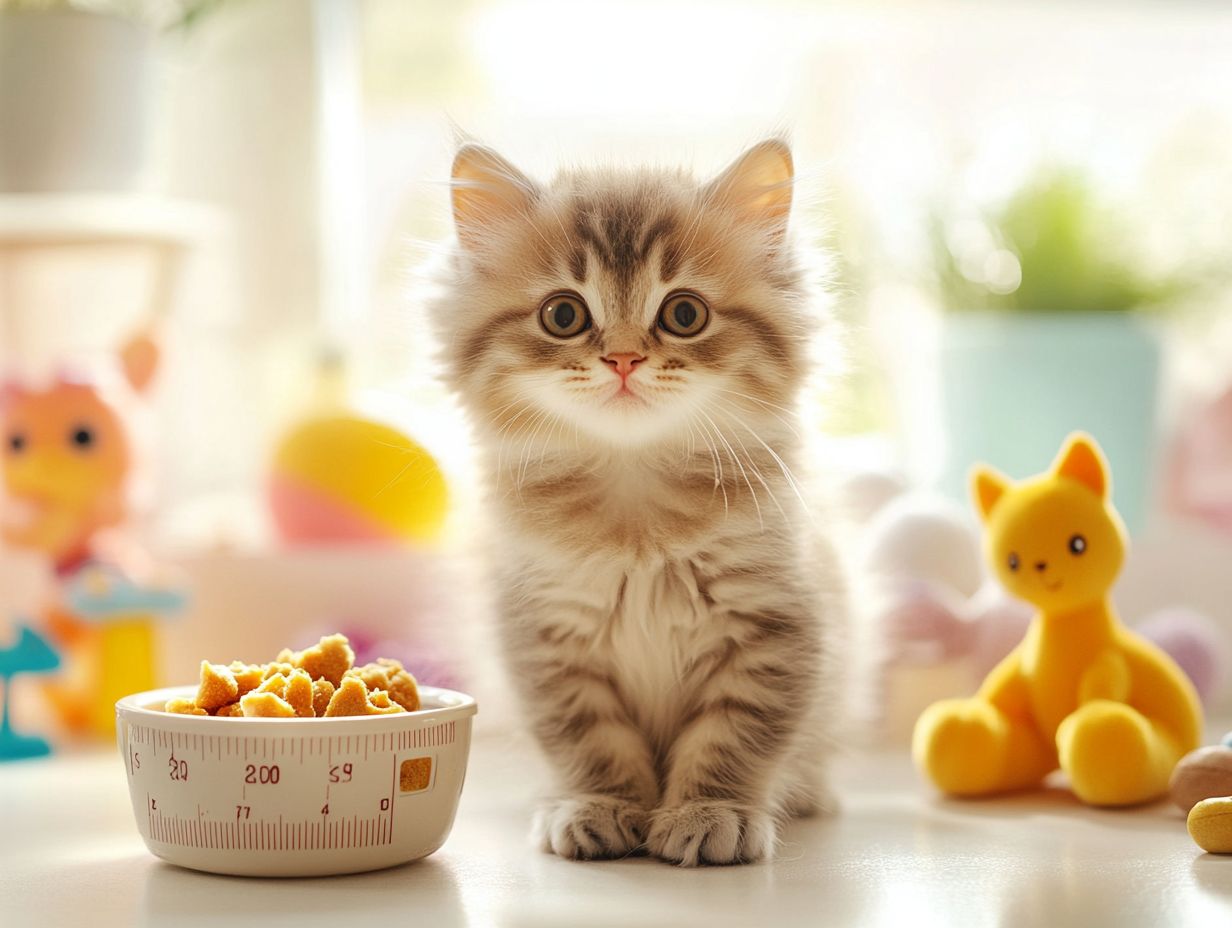
The activity levels of kittens significantly influence their nutritional needs and feeding regimens. Active kittens require a higher caloric intake to support their growth during this active stage, while more sedentary kittens may need to reduce their caloric intake to prevent overeating and obesity.
Understanding this interaction is essential for responsible pet owners to ensure their kittens’ proper health and development. You can monitor your kitten’s activity by observing the frequency and enthusiasm of their playtimes, as well as their energy levels and behaviors throughout the day. Additionally, it is beneficial to monitor weight and body condition score as part of regular health checks.
If your kitten is frequently bouncing around and playing energetically, their caloric intake should align with their energy needs. Conversely, if your kitten prefers lounging over playing, consider reducing the amount you feed them and opting for lower-calorie food options.
Always consult with a veterinarian to create a feeding plan tailored to your kitten’s specific activity levels and lifestyle, ensuring they receive the necessary nutrients for healthy growth.
3. Breed and Size
Different breeds and sizes of kittens have unique feeding needs that can significantly impact their growth and body condition. It is important to consider these differences when determining the appropriate amount of nutrition for each kitten.
For instance, Maine Coon kittens, one of the largest breeds with a robust bone structure, typically require more protein and calories to support their growth spurts. In contrast, smaller breeds like the Singapura may thrive on a more moderate diet and require fewer calories due to their petite size. Individual metabolic rates may vary, emphasizing the need for personalized feeding plans.
Caregivers should remain attentive and adjust feeding amounts as necessary, based on each kitten’s activity level and metabolism. This approach ensures proper growth and body condition as the young kittens transition into adulthood.
How Often to Feed Your Kitten?
A consistent feeding schedule is essential for a kitten’s overall health and helps establish healthy eating habits.
The frequency of feedings typically depends on the kitten’s age, activity level, and dietary requirements, leading to a structured meal schedule.
1. Age and Weight
As your kitten grows, it is important to transition them to an adult diet safely to ensure they continue to receive appropriate nutrition. Be sure to consult with your veterinarian for guidance on this transition.
Additionally, proper food storage and handling are crucial to maintain freshness and prevent spoilage. Always check expiration dates and refrigerate any opened food. Recognizing signs of spoilage, such as changes in color, odor, or texture, is essential for food safety awareness.
The age and weight of your kitten are crucial factors in determining how often to feed them each day. Younger kittens, especially those under six months old, typically require more frequent meals to meet their higher caloric needs as established by guidelines from AAFCO and WSAVA, which support their rapid growth. Implementing a consistent meal-based schedule is essential.
These young kittens usually require four meals a day, which provide the necessary calories to sustain their increased activity levels. As they approach six months of age, pet owners should gradually transition them to three meals a day, as their metabolism begins to stabilize.
By the time they reach one year, this can be reduced to two meals a day. This approach not only accommodates their changing nutritional needs but also helps establish a healthy feeding routine that lays the groundwork for proper adult nutrition as they continue to mature.
2. Activity Level
The frequency with which you should feed your kitten is influenced by their activity level and dietary needs. More active kittens may require more frequent meals with high-quality kitten food to maintain their energy levels, while less active kittens can benefit from a regular feeding schedule to prevent overeating and weight gain.
Monitoring your kitten’s activity level is essential in determining their nutritional needs. If your kitten is frequently zooming around and playing with toys, it indicates a higher activity level, meaning they will need more calories and, consequently, more feeding opportunities that include both wet and dry kitten food throughout the day.
Conversely, a less active kitten may not need as many feeding opportunities, and their meals can be smaller portion sizes to help prevent excessive weight gain. Additionally, adjusting feeding times to align with periods of high activity will ensure that the kitten receives adequate nutrition for both play and growth, supporting their digestive health.
3. Breed, Size, and Nutritional Adequacy
The breed and size of your kitten significantly influence their feeding frequency, as different breeds have varying nutritional needs and food preferences. Larger breeds may require more frequent meals to support their growth, while smaller breeds might thrive on a different feeding schedule.
For example, a Maine Coon, known for its larger stature, may benefit from three to four meals a day to meet its energy demands. In contrast, a tiny Balinese kitten may only need two meals to maintain its health while still allowing time for playful activities.
Understanding the specific nutritional requirements of each breed is essential; high-energy breeds often need animal-source protein-rich diets to fuel their activity, while calmer breeds may require fewer calories. Establishing an appropriate feeding routine based on these factors can promote optimal health and growth, ensuring that every kitten receives the care it needs. Make sure to consult feeding guides and a veterinarian for personalized advice, particularly for kittens with specific health conditions such as kidney disease or diabetes.
What is the Recommended Feeding Schedule for Kittens?
Establishing a recommended feeding schedule for kittens is crucial for promoting healthy growth and development. This feeding schedule should be adjusted as the kitten matures, with specific guidelines for different age ranges and feeding options:
- 4 to 6 weeks
- 6 to 12 weeks
- 3 to 6 months
- 6 months and older
1. 4 to 6 Weeks Old
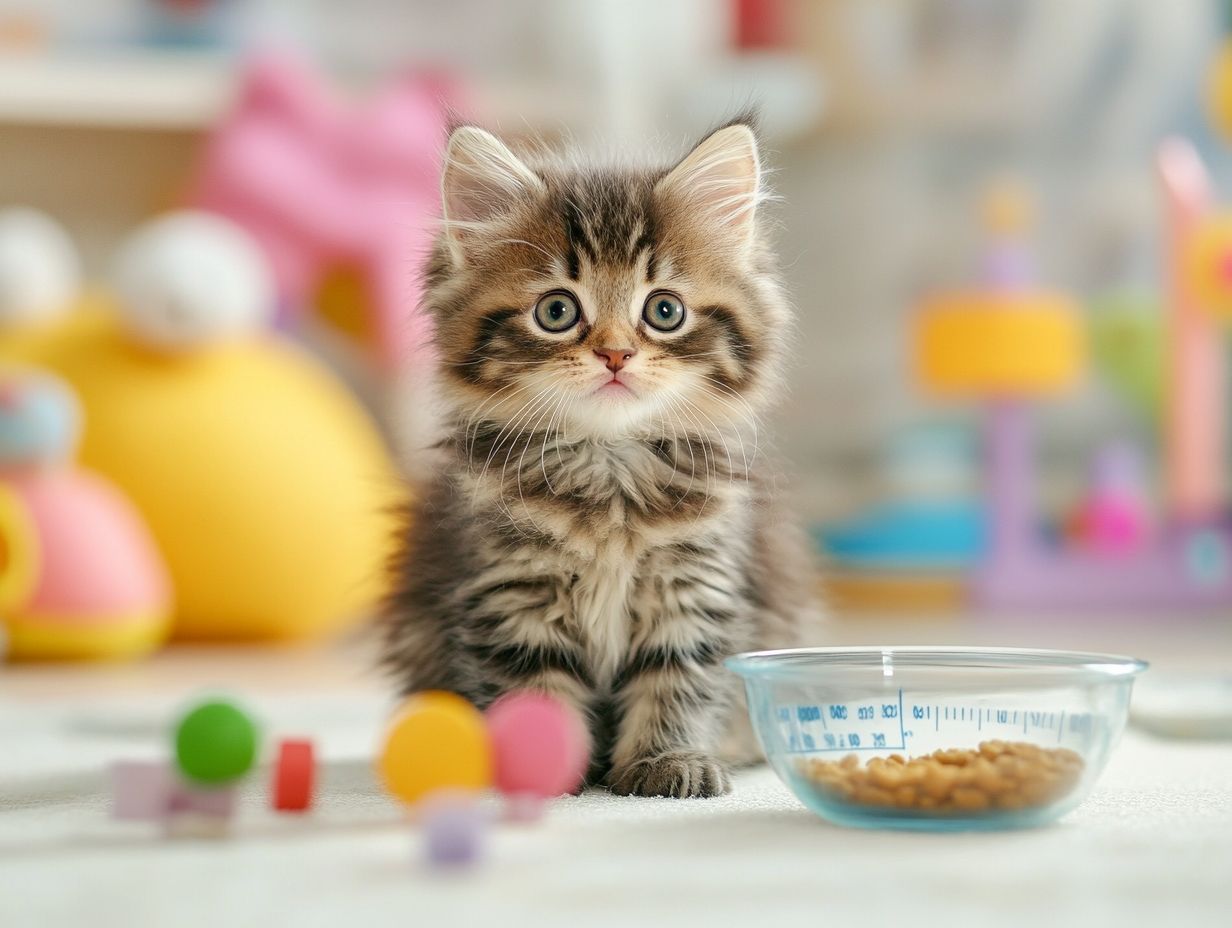
Kittens aged 4 to 6 weeks are primarily fed a combination of milk replacer and solid food, depending on the type of milk they have received and their transition from nursing. During this transition, high-quality wet food should be gradually introduced, focusing on nutritional adequacy.
As kittens develop their chewing skills during this phase, it is essential to provide the appropriate type of food to facilitate this change, introducing different flavors and textures. It is recommended to feed commercially available kitten food suitable for their age in small amounts—approximately 2 tablespoons per meal, three to four times a day.
Canned foods that are high in protein and nutrients, such as chicken or turkey pâté, are appropriate options. This stage of a kitten’s life is critical, and close monitoring is necessary.
If a kitten does not appear to be thriving, exhibits low energy, fails to gain weight, or has poor stool output, it may be necessary to adjust the feeding schedule or change the type of food.
Additionally, proper food storage and handling practices are essential to prevent spoilage. Always check expiration dates and store food in a cool, dry place. Regular veterinary check-ups are recommended to ensure that your kitten’s dietary needs are being met and to adjust the feeding schedule as necessary.
2. 6 to 12 Weeks Old
Kittens aged 6 to 12 weeks should be fed a combination of high-quality wet and dry food that meets AAFCO nutritional standards on a regular schedule to satisfy their developing nutritional needs. At this age, kittens generally require more frequent meals.
For optimal health, it is recommended to feed these young animals four times a day, ensuring that each meal includes a portion size appropriate for their weight and growth rate. Offering a variety of food types and flavors not only makes mealtime more enjoyable but also helps establish healthy eating habits.
Mixing different animal-based proteins, such as chicken and fish, along with various textures, can be very beneficial. Look for products labeled as “complete and balanced” by AAFCO, which can provide a basis for quality food. This approach not only promotes nutritional balance but also reduces the likelihood of picky eating as they mature, fostering a lifetime of adventurous eating. However, be cautious about feeding too much fish due to high mercury levels; moderation is key.
Hydration is also important; including wet food in their diet is a good source of moisture and can help prevent urinary tract issues, which are common in cats.
3. 3 to 6 Months Old
During the 3 to 6-month stage, your kitten’s feeding schedule should be adjusted to accommodate their growing appetite and ongoing nutritional needs from earlier months. At this stage, establishing a consistent feeding routine is crucial for their physical and mental development, emphasizing hydration and moisture content in their diet.
As kittens become more exploratory and active, their nutritional requirements increase. This can be addressed by both increasing the number of meals and the portion sizes based on their weight and growth rate. If they were previously fed two meals a day, switching to three or even four smaller portions is beneficial.
This approach ensures they receive the necessary nutrients without overloading their digestive systems. It is also important to regularly monitor your kitten’s body condition score; they should neither be too skinny nor too overweight. Look for a slight waist with ribs that can be easily felt.
Based on this assessment, adjust their feeding habits to promote optimal growth and prevent potential obesity.
4. 6 Months and Older
At six months of age, kittens should begin transitioning to adult cat food, and their feeding schedule should reflect this change. This stage is crucial for ensuring they receive the proper nutrients and maintain a healthy weight as they grow into adulthood.
The transition to adult food should be gradual; mixing a small amount of adult food into their current kitten diet can facilitate this process, with the amount slowly increased over a week or two to prevent digestive upset. It’s important to consider the kitten’s activity level and body condition score during this transition to ensure they maintain a healthy weight as they grow.
It’s also important to monitor the kitten’s response during this transition. If they show any signs of an upset stomach or changes in behavior, the transition should be slowed. Feeding schedules should align with the kitten’s energy levels, ensuring they receive the necessary nutrition when they are most active. Providing access to water and supplements like fish oil can support their exercise needs and well-being.
This approach will help support their growth and well-being during this critical stage of development. For more information, check out the Kitten Feeding Guide: How Much and How Often to Feed.
What to Do If Your Kitten is Not Eating?
When a kitten refuses to eat, it can be concerning, as this behavior may indicate various underlying problems or diseases. Identifying the cause is crucial, and a veterinarian can advise owners on the necessary interventions to ensure the kitten’s nutritional needs and dietary needs are met.
There are several reasons why a kitten might stop eating. Stress from a new environment can lead to anxiety, causing the kitten to lose its appetite. Certain illnesses may also result in decreased food intake. Additionally, a kitten might simply be picky and prefer specific foods. Temporary appetite suppression can occur after vaccinations or due to changes in routine.
To address these issues, pet owners can take several steps:
- Feed the kitten in a calm and quiet environment.
- Offer foods with different textures and flavors.
- Establish a consistent feeding schedule.
If the loss of appetite persists for more than 24 hours or is accompanied by other concerning symptoms, such as lethargy, it is important to consult a veterinarian, as prolonged periods without food can lead to hepatic lipidosis.
What to Do If Your Kitten is Overeating?
If your kitten is overeating, it may lead to health complications such as obesity, which can negatively impact their overall well-being. It is essential to control portion sizes and adjust the frequency of meals to help manage their weight and promote healthy eating habits. Monitor the kitten’s body condition score regularly and adjust portions based on observations, rather than just relying on mealtime tips.
Additionally, do not force food if a kitten refuses to eat, as this can create negative associations with mealtime and exacerbate anxiety.
Early detection of overeating is crucial; common symptoms include a sudden lack of energy, excessive vomiting, and a rapid increase in weight. Consult your veterinarian for proper diagnosis and management of these symptoms.
Establishing a feeding schedule and dividing meals into smaller portions throughout the day can help prevent these issues. Consistent feeding times create an expected routine that fosters good eating habits. Measuring food portions allows for better calorie control, and adjustments should be made based on the kitten’s activity level and growth stage, considering recommended calorie ranges according to AAFCO standards.
Additionally, regular check-ups with the veterinarian will monitor the kitten’s health and help adjust their dietary needs as they grow.
How to Transition Your Kitten to Adult Cat Food?
The transition from kitten food to adult cat food like Hill’s® or Iams® is a significant milestone in a cat’s development and should be carefully planned and executed to meet their nutritional requirements. It’s important to evaluate the protein content in both kitten and adult food, given that cats are obligate carnivores. Gradually incorporating adult food into their regular diet can facilitate this transition and ensure that kittens continue to receive proper nutrition.
This process typically begins around 12 months of age, when young cats have the teeth and digestive capacity to handle more complex ingredients. Start by adding small portions of adult food to their existing kitten food, gradually increasing the ratio over the next week or two. It is essential to consult a veterinarian during this transition to discuss the benefits and risks associated with switching foods.
It is important to monitor their response closely; if they exhibit signs of digestive distress, such as vomiting or abnormal stools, it may indicate the need for a slower transition. Regular veterinary appointments during this period are essential, as veterinarians can provide personalized advice on nutrient needs and serving sizes to ensure that young cats grow properly throughout the transition.
Frequently Asked Questions
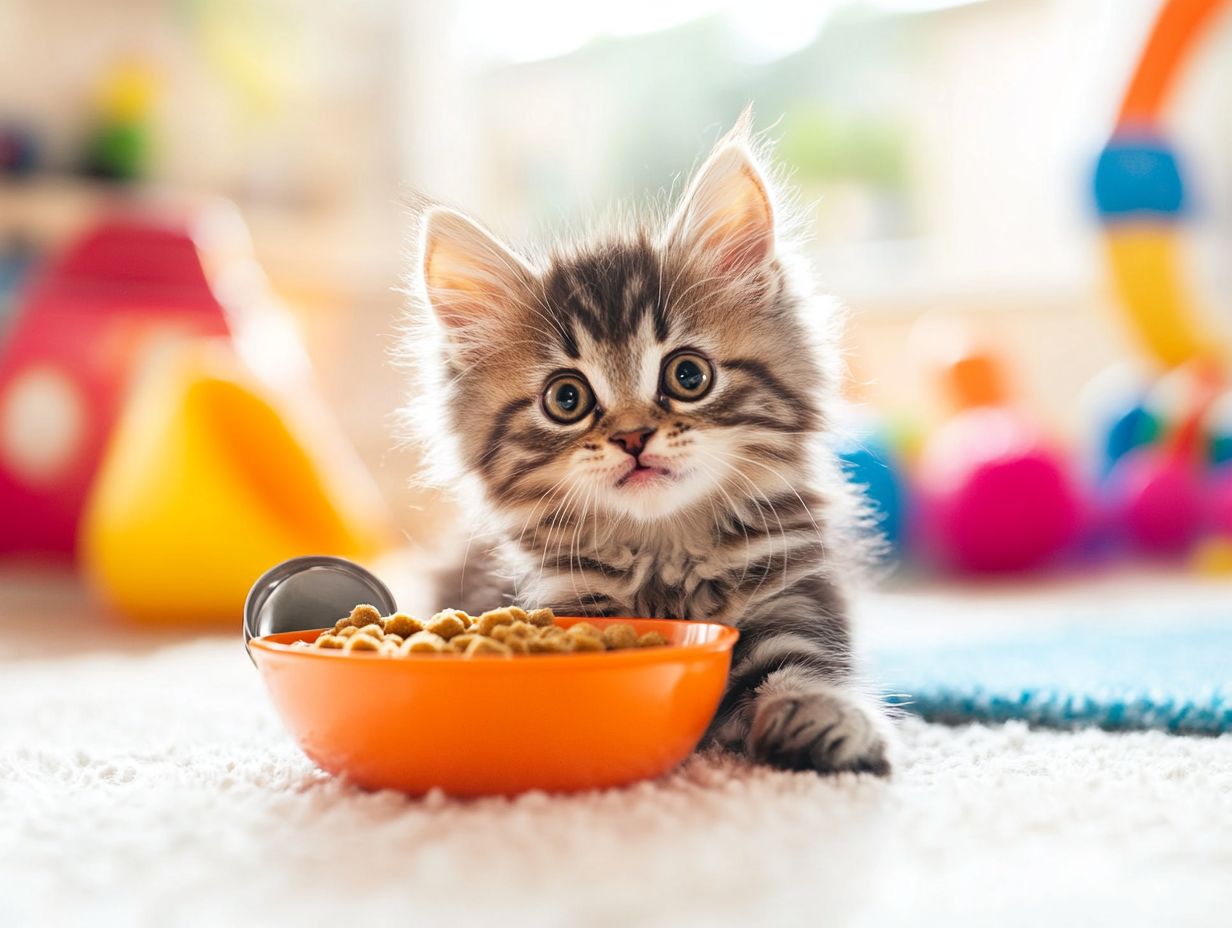
How much should I feed my kitten?
The recommended feeding amount for a kitten includes about 1/2 cup of dry kitten food per day, divided into 3-4 meals. This feeding schedule may vary depending on the kitten’s age, weight, activity level, and dietary needs. Consider consulting a veterinarian for personalized feeding guides, ensuring the nutritional needs are met with quality food options like ACANA® or Royal Canin®. Monitor your kitten’s Body Condition Score (BCS) to assess if they are receiving adequate nutrition.
How often should I feed my kitten?
Kittens require a meal-based schedule with more frequent feeding habits compared to adult cats. It is recommended to feed them 3-4 times a day, with at least 4-hour intervals between each meal. This mealtime routine supports their growth phase and digestive health.
Can I leave food out for my kitten to eat freely?
It is not recommended to leave food out for kittens to eat freely. They may overeat and become overweight, affecting their healthy weight and leading to health problems such as obesity and diarrhea. Offer a balanced mix of dry food and wet kitten food to meet their moisture content and hydration needs, while emphasizing the importance of portion control and timed feedings.
How can I tell if my kitten is getting enough food?
You can monitor your kitten’s weight and body condition. If they are gaining weight at a healthy rate and have a good body condition, then they are likely getting enough food. Providing high-quality food with nutritional adequacy and considering supplements like fish oil can support their healthy growth.
Is it okay to give my kitten treats in addition to their regular meals?
Treats, including flavors like chicken recipe or premium pate, should be given sparingly and should not exceed 10% of your kitten’s total daily caloric intake. Too many treats can lead to nutritional imbalances and health issues, so monitor their food preferences and ensure a balanced diet. It’s advisable to check with a vet for suitable treat options and amounts.
When should I switch my kitten to adult cat food?
Kittens can be transitioned to adult cat food once they reach 12 months of age. This transition process should consider their feeding routine and exercise needs. However, if your kitten is a large breed, it is recommended to wait until they are 15-18 months old to fully meet their growth and development requirements.
What about specialized diets for kittens?
Kittens with different life stages, such as pregnant or nursing cats, have unique nutritional needs. It’s important to consult resources or a veterinarian for specialized diets if needed.
How should I store kitten food to ensure safety and nutritional integrity?
Proper storage of both dry and wet kitten food is essential to avoid spoilage. Keep dry food in a cool, dry place and seal it tightly. Store wet food in the refrigerator once opened and use it within a few days. Avoid harmful practices that could compromise their health.
